Do you have a question about the Triumph Sprint GT and is the answer not in the manual?
Explains warning, caution, and note symbols used in the handbook.
Describes warning labels on the motorcycle and refers to handbook pages for locations.
Recommends authorized dealer for maintenance and provides contact info.
Warns against tampering with the noise control system and outlines legal prohibitions.
Thanks for choosing Triumph, emphasizes reading handbook for safe operation and recommends safety courses.
Encourages feedback on ownership experience via email survey.
States handbook is a permanent part and must be read before riding.
States publication is based on latest info and reserves right to make changes.
States motorcycle is for on-road use only, not off-road, and not for towing or sidecars.
Warns about flammable gasoline and poisonous exhaust fumes.
Provides warnings about riding under influence, fatigue, licensing, and defensive riding.
Explains wobble/weave and how to correct it by easing off throttle and holding handlebars.
Emphasizes knowing and respecting road rules and handbook content.
Notes absence of spark arresters and potential legal issues in certain areas.
Advises on wearing protective gear, including DOT-approved helmets, eye protection, gloves, boots, and clothing.
Stresses keeping hands on handlebars and using footrests for safety and control.
Details safe parking practices: turning off engine, engaging gear, and avoiding hot surfaces.
Warns against non-approved parts/accessories and modifications, citing potential hazards.
Recommends consulting dealer for doubts and warns against operating a faulty motorcycle.
Warns about exceeding bank angle limits and potential loss of control.
Ensures all required equipment is installed and warns about illegal modifications affecting safety.
Stresses taking motorcycle to dealer after an accident for inspection and repair to prevent further incidents.
Illustrates locations of various warning labels on the motorcycle.
Illustrates additional locations of warning labels on the motorcycle.
Diagram showing numbered parts of the Sprint ST motorcycle.
Diagram showing further numbered parts of the Sprint ST motorcycle.
Diagram showing numbered parts of the Sprint GT motorcycle.
Diagram showing further numbered parts of the Sprint GT motorcycle.
Diagram showing controls and components on the handlebars for both models.
Explains the location of the VIN on the frame and label, with space to record it.
Explains the location of the engine serial number and provides space to record it.
Describes how to adjust brake and clutch levers for comfort.
Details operation of engine stop switch and starter button.
Details operation of headlight dimmer, turn signal, horn, and pass buttons.
Specifies fuel grade, cautions about catalytic converter and fuel levels.
Explains use of side stand and center stand for parking.
Describes the location and use of the lifting handle for center stand parking.
Details location of tool kit and handbook in stowage box.
Provides instructions on how to remove and re-install the Sprint ST seat.
Provides instructions on how to remove and re-install the Sprint GT seat.
Offers advice on how to care for the seat to prevent damage.
Explains how to use helmet hooks located beneath the seat.
Details how to store a Triumph accessory D-lock under the seat.
Explains how to install and remove panniers for the Sprint GT.
Describes the operation of pannier locks and lids, including load limits.
Details the location and usage of the 12V accessory socket.
Guides on the recommended procedures for breaking in a new motorcycle.
Lists daily safety checks to ensure a safe and reliable ride.
Diagram showing the layout of the instrument panel and identification of indicators.
Explains the function of the speedometer in indicating road speed.
Explains the function of the tachometer in indicating engine speed (RPM).
Describes the odometer and trip meter functions and how to reset trip meters.
Details functions of clock, trip computer, fuel consumption, range, trip distance, time, and speed.
Explains how to reset trip computer displays like fuel consumption, distance, time, and speed.
Describes how to adjust the motorcycle's clock time.
Explains the coolant temperature gauge and associated warning light.
Explains the fuel gauge, including low fuel warning light illumination.
Details the function of turn signals, high beam, low fuel, neutral, oil pressure, and coolant warning lights.
Explains the engine management malfunction indicator light and its implications.
Describes the function of the alarm indicator light, which activates if an alarm is fitted.
Explains the ABS indicator light and its meaning for system availability.
Describes the ignition key, its uses, and the importance of keeping the key number tag safe.
Details the four positions of the ignition switch and how to lock the steering.
Explains how to adjust lever reach for comfort and proper operation.
Describes the engine stop switch and starter button functions.
Details operation of headlight dimmer, turn signal switch, horn, and pass button.
Explains how the starter button operates the electric starter, including lockout conditions.
Describes how to operate the turn signal switch to indicate turns.
Explains how to use the horn button to alert others.
Describes the function of the pass button for headlight flashing.
Specifies fuel grade and cautions about catalytic converter and fuel levels.
Specifies the required unleaded gasoline octane rating and warnings about oxygenated fuels.
Discusses the use of ethanol blends in the motorcycle and their compatibility.
States that gasolines with up to 15% MTBE are permitted.
Warns against using fuels containing methanol due to potential damage.
Details how to open and close the fuel tank cap correctly.
Provides instructions on how to fill the fuel tank safely, avoiding overfilling.
Explains the use of the side stand for parking and related safety warnings.
Details how to use the center stand for parking and warnings about incorrect use.
Describes the location and use of the lifting handle for center stand parking.
Details location of tool kit and handbook in stowage box.
Provides instructions on how to remove and re-install the Sprint ST seat.
Provides instructions on how to remove and re-install the Sprint GT seat.
Offers advice on how to care for the seat to prevent damage.
Explains how to use helmet hooks located beneath the seat.
Details how to store a Triumph accessory D-lock under the seat.
Explains how to install and remove panniers for the Sprint GT.
Details how to install and lock panniers onto the motorcycle mounting points.
Details how to unlock and remove panniers from the motorcycle mounting points.
Describes the operation of pannier locks and lids, including load limits.
Warns against removing or adjusting the pannier link bar due to stability issues.
Warns about incorrect loading, distribution, security, and maximum weight limits.
Details the location and usage of the 12V accessory socket.
Guides on the recommended procedures for breaking in a new motorcycle.
Lists daily safety checks to ensure a safe and reliable ride.
Ensures ABS warning light behavior is normal for models equipped with ABS.
Specifies minimum brake pad lining thickness for replacement.
Checks brake fluid levels and for any leakage.
Checks front forks for smooth action and leaks.
Checks throttle grip free play and return.
Checks clutch operation and cable free play.
Checks coolant level in the expansion tank.
Checks all lights, horn, and electrical systems function correctly.
Confirms the engine stop switch functions to turn the engine off.
Ensures stands return fully by spring tension and are not damaged.
Provides steps for stopping the motorcycle engine using ignition and stop switch.
Details the procedure for starting the motorcycle engine, including cold start tips.
Explains how to move off from a stop, including clutch and throttle control.
Guides on shifting gears using the clutch and gear shift pedal, with warnings.
Details correct braking technique, using both brakes and observing warnings.
Warns about caution during braking, acceleration, and turning, especially in adverse conditions.
Advises on using engine braking and intermittent brake application on steep gradients.
Explains ABS function, warning light, rider perception, and road surface effects.
Provides instructions for parking on level surfaces, hills, and inclines, with ABS warning.
Notes on using parking lights and battery discharge risk.
Warns against parking on soft or steep surfaces that could cause falls.
Warns about gasoline flammability and fire risks in garages.
Discusses factors affecting handling at high speeds, including maintenance and steering.
Emphasizes essential maintenance for high-speed operation.
Checks handlebar smoothness, free play, and cable restrictions for high-speed use.
Ensures luggage is closed, locked, securely fitted, evenly loaded, and not overloaded.
Checks brake function and ABS light status for high-speed operation.
Emphasizes tire condition, pressure, and balance for safe high-speed riding.
Ensures sufficient fuel for increased consumption during high-speed operation.
Confirms correct engine oil level and type for high-speed operation.
Checks coolant level in the expansion tank.
Ensures all lights, horn, and electrical systems function properly.
Visually checks that all fasteners are tight.
Warns that incorrect loading can cause unsafe conditions and accidents.
Warns against installing accessories that impair control, visibility, or clearance.
Restricts speed to 80 mph (130 km/h) with accessories or payload due to stability changes.
Restricts high-speed operation to authorized closed-course conditions only.
Instructs passenger to remain still, hold on, and lean with the rider.
Warns against carrying animals due to unpredictable movements causing loss of control.
Explains how passenger affects handling and braking, recommending familiarity.
Warns against storing items between frame and tank, which restricts steering.
States passenger must be tall enough to reach footrests for secure seating.
Limits weight of small objects on seat/rack and warns against impairment of control.
Warns Sprint ST owners not to rest luggage on rear bodywork to prevent overheating.
Covers inspection and maintenance of steering and wheel bearings.
Details inspection and adjustment of front forks and suspension settings.
Covers adjustment of rear suspension rebound damping and spring pre-load.
Covers tire inflation pressures, wear, and replacement guidelines.
Details battery removal, disposal, maintenance, discharge, and charging.
Details the location of the fuse box for the Sprint ST.
Instructions for replacing the main beam headlight bulb.
Instructions for replacing the position lamp bulb.
States the brake/tail light is a sealed LED unit and advises on defective lights.
Instructions for replacing front and rear turn signal bulbs.
Instructions for replacing the license plate light bulb.
General advice on bulb replacement and handling.
Provides instructions for cleaning the windshield.
Emphasizes carrying out maintenance as per schedule and warnings about incorrect maintenance.
Details the maintenance schedule for various operations at different mileage intervals.
Details the maintenance schedule for various operations at different mileage intervals.
Highlights the importance of maintaining correct engine oil levels and changing oil/filter.
Provides instructions for checking the engine oil level accurately.
Warns that insufficient oil causes engine damage and advises checking oil pressure indicator.
Warns about engine damage from insufficient oil and advises checking oil pressure.
Provides detailed steps for changing engine oil and oil filter, including warnings.
Specifies recommended engine oil type, grade, and cautions against additives.
Provides environmental guidelines for disposing of used engine oil and filters.
Emphasizes checking coolant level and using correct coolant type.
Explains the necessity of corrosion inhibitors in coolant to prevent system damage.
Details how to inspect the coolant level in the expansion tank.
Provides instructions for adjusting the coolant level, with warnings about hot engines.
Instructs to check radiator hoses for damage and radiator fins for obstructions.
States coolant change should be done by an authorized dealer.
Details inspection of throttle grip for smooth operation and free play.
Provides instructions for adjusting throttle cable free play and warnings about incorrect adjustment.
Explains clutch operation, free play checks, and adjustment procedures.
Covers drive chain checking, adjustment, lubrication, and warnings about wear.
Details the necessity and procedure for lubricating the drive chain.
Explains how to measure the vertical movement of the drive chain.
Provides steps for adjusting chain free-movement and tightening bolts.
Details how to inspect chain and sprocket wear and when to replace them.
Explains how to inspect brake pads for wear and when replacement is needed.
Recommends a break-in period for new brake pads and discs for optimal performance.
States that brake pad wear is automatically compensated and no adjustment is needed.
Covers inspection and changing of disc brake fluid, emphasizing DOT 4 and contamination warnings.
Details how to inspect and adjust brake fluid levels in reservoirs, with warnings.
Explains level inspection and adjustment for the rear brake fluid reservoir on Sprint ST.
Explains level inspection and adjustment for the rear brake fluid reservoir on Sprint GT.
Details checking the brake light switches for proper operation and warnings about defective lights.
Covers inspection of steering head bearings for free play and wheel bearings.
Details inspecting steering head bearings for condition and free play.
Explains how to inspect wheel bearings for play, noise, or smoothness.
Covers inspection of front forks for damage, leaks, and smooth operation.
Provides suggested suspension settings for Sprint ST and GT models based on loading.
Describes front suspension adjustability for pre-load and provides setting guidelines.
Explains how to adjust spring pre-load on the forks for rider preference.
Covers adjustment of rear suspension rebound damping and spring pre-load.
Details how to adjust the rear suspension rebound damping setting.
Provides specific instructions for adjusting the spring pre-load on Sprint ST forks.
Provides specific instructions for adjusting the spring pre-load on Sprint GT forks.
Covers tire markings, inflation pressures, and warnings about incorrect inflation.
Explains the importance of correct tire inflation for stability and rider comfort.
Shows typical wheel markings indicating suitability for tubeless tires.
Discusses tire wear susceptibility to punctures and the recommendation against using worn tires.
Specifies minimum tread depth measurements for tire replacement.
Provides guidelines for approved tire combinations and warns against non-approved tires.
Warns about risks of incorrectly seated tires, pressures, or unfamiliar handling after replacement.
Warns about risks of operating with damaged or punctured tires, affecting stability.
Stresses the importance of accurate wheel balance for safe handling and warns against clip-on weights.
Details battery safety precautions, including handling acid and avoiding sparks.
Provides step-by-step instructions for removing the battery from Sprint ST and GT models.
Covers cleaning battery terminals and notes that sealed batteries require minimal maintenance.
Provides guidelines for environmentally sound disposal of used batteries.
Warns about battery discharge effects on lifespan and potential internal damage.
Provides guidance on battery charging, selecting a charger, and safety precautions.
Advises on inspecting and charging the battery during storage to prevent sulphation.
Provides step-by-step instructions for installing the battery, including terminal connections.
Details the location of the fuse box for the Sprint ST.
Lists fuses, their protected circuits, positions, and ratings for the Sprint ST.
Lists fuses, protected circuits, positions, and ratings for the Sprint GT.
Provides warnings and cautions regarding headlight adjustment and use in closed-course conditions.
Explains how to adjust headlights vertically and horizontally.
Details how to adjust the main beam horizontally for proper road illumination.
Provides instructions for adjusting the main beam vertically.
Explains how to adjust the dimmed headlight beam vertically.
Details how to adjust the dimmed headlight beam horizontally.
Provides instructions for replacing dipped headlight bulbs, noting panel removal.
Details the procedure for replacing the main beam bulb, requiring cockpit removal.
Instructions for replacing the position lamp bulb.
States the brake/tail light is a sealed LED unit and advises on defective lights.
Instructions for replacing front and rear turn signal bulbs.
Instructions for replacing front turn signal bulbs.
Instructions for replacing rear turn signal bulbs.
Instructions for replacing the license plate light bulb.
General advice on bulb replacement and handling.
Provides instructions for cleaning the windshield.
Emphasizes frequent cleaning for appearance preservation and warns against certain cleaning products.
Details precautions before washing, like covering openings and removing jewelry.
Lists areas to avoid spraying water with force, such as instruments and bearings.
Provides instructions for cleaning the seat using soap and water, warning against chemicals.
Advises on cleaning unpainted aluminum items with proprietary cleaners.
Provides instructions for cleaning the exhaust system, including warnings about heat and products.
Details steps for preparing the motorcycle for storage, including fuel, oil, and tires.
Explains steps to take after retrieving the motorcycle from storage, including checks and test rides.
Lists overall length, width, height, wheelbase, and seat height for both models.
Provides wet weight and maximum payload for both models.
Details engine type, displacement, bore, stroke, compression ratio, numbering, firing order, and starting system.
Lists maximum power and torque for both Sprint ST and GT models.
Specifies the lubrication system type (Forced Lubrication - Wet sump).
Details coolant type, anti-freeze ratio, capacity, and thermostat opening temperature.
Describes fuel system type, injectors, fuel pump, and fuel pressure.
Specifies fuel type (octane rating) and steel fuel tank capacity.
Details ignition system, rev limiter, spark plug type, gap, and tolerance.
Lists transmission type, clutch type, drive chain details, and gear ratios.
Lists tire pressures and approved tire sizes/options for both models.
Warns against mixing tires from different manufacturers or specifications.
Details electrical specifications like battery, alternator, headlights, and lights.
Lists frame rake and trail measurements.
Provides tightening torque values for oil filter, drain plug, spark plug, and clamp bolt.
Specifies engine oil, brake/clutch fluid, coolant, bearing grease, and drive chain lubricant.
An alphabetical index of topics covered in the manual with corresponding page numbers.
An alphabetical index of topics covered in the manual with corresponding page numbers.
Explains warning, caution, and note symbols used in the handbook.
Describes warning labels on the motorcycle and refers to handbook pages for locations.
Recommends authorized dealer for maintenance and provides contact info.
Warns against tampering with the noise control system and outlines legal prohibitions.
Thanks for choosing Triumph, emphasizes reading handbook for safe operation and recommends safety courses.
Encourages feedback on ownership experience via email survey.
States handbook is a permanent part and must be read before riding.
States publication is based on latest info and reserves right to make changes.
States motorcycle is for on-road use only, not off-road, and not for towing or sidecars.
Warns about flammable gasoline and poisonous exhaust fumes.
Provides warnings about riding under influence, fatigue, licensing, and defensive riding.
Explains wobble/weave and how to correct it by easing off throttle and holding handlebars.
Emphasizes knowing and respecting road rules and handbook content.
Notes absence of spark arresters and potential legal issues in certain areas.
Advises on wearing protective gear, including DOT-approved helmets, eye protection, gloves, boots, and clothing.
Stresses keeping hands on handlebars and using footrests for safety and control.
Details safe parking practices: turning off engine, engaging gear, and avoiding hot surfaces.
Warns against non-approved parts/accessories and modifications, citing potential hazards.
Recommends consulting dealer for doubts and warns against operating a faulty motorcycle.
Warns about exceeding bank angle limits and potential loss of control.
Ensures all required equipment is installed and warns about illegal modifications affecting safety.
Stresses taking motorcycle to dealer after an accident for inspection and repair to prevent further incidents.
Illustrates locations of various warning labels on the motorcycle.
Illustrates additional locations of warning labels on the motorcycle.
Diagram showing numbered parts of the Sprint ST motorcycle.
Diagram showing further numbered parts of the Sprint ST motorcycle.
Diagram showing numbered parts of the Sprint GT motorcycle.
Diagram showing further numbered parts of the Sprint GT motorcycle.
Diagram showing controls and components on the handlebars for both models.
Explains the location of the VIN on the frame and label, with space to record it.
Explains the location of the engine serial number and provides space to record it.
Describes how to adjust brake and clutch levers for comfort.
Details operation of engine stop switch and starter button.
Details operation of headlight dimmer, turn signal, horn, and pass buttons.
Specifies fuel grade, cautions about catalytic converter and fuel levels.
Explains use of side stand and center stand for parking.
Describes the location and use of the lifting handle for center stand parking.
Details location of tool kit and handbook in stowage box.
Provides instructions on how to remove and re-install the Sprint ST seat.
Provides instructions on how to remove and re-install the Sprint GT seat.
Offers advice on how to care for the seat to prevent damage.
Explains how to use helmet hooks located beneath the seat.
Details how to store a Triumph accessory D-lock under the seat.
Explains how to install and remove panniers for the Sprint GT.
Describes the operation of pannier locks and lids, including load limits.
Details the location and usage of the 12V accessory socket.
Guides on the recommended procedures for breaking in a new motorcycle.
Lists daily safety checks to ensure a safe and reliable ride.
Diagram showing the layout of the instrument panel and identification of indicators.
Explains the function of the speedometer in indicating road speed.
Explains the function of the tachometer in indicating engine speed (RPM).
Describes the odometer and trip meter functions and how to reset trip meters.
Details functions of clock, trip computer, fuel consumption, range, trip distance, time, and speed.
Explains how to reset trip computer displays like fuel consumption, distance, time, and speed.
Describes how to adjust the motorcycle's clock time.
Explains the coolant temperature gauge and associated warning light.
Explains the fuel gauge, including low fuel warning light illumination.
Details the function of turn signals, high beam, low fuel, neutral, oil pressure, and coolant warning lights.
Explains the engine management malfunction indicator light and its implications.
Describes the function of the alarm indicator light, which activates if an alarm is fitted.
Explains the ABS indicator light and its meaning for system availability.
Describes the ignition key, its uses, and the importance of keeping the key number tag safe.
Details the four positions of the ignition switch and how to lock the steering.
Explains how to adjust lever reach for comfort and proper operation.
Describes the engine stop switch and starter button functions.
Details operation of headlight dimmer, turn signal switch, horn, and pass button.
Explains how the starter button operates the electric starter, including lockout conditions.
Describes how to operate the turn signal switch to indicate turns.
Explains how to use the horn button to alert others.
Describes the function of the pass button for headlight flashing.
Specifies fuel grade and cautions about catalytic converter and fuel levels.
Specifies the required unleaded gasoline octane rating and warnings about oxygenated fuels.
Discusses the use of ethanol blends in the motorcycle and their compatibility.
States that gasolines with up to 15% MTBE are permitted.
Warns against using fuels containing methanol due to potential damage.
Details how to open and close the fuel tank cap correctly.
Provides instructions on how to fill the fuel tank safely, avoiding overfilling.
Explains the use of the side stand for parking and related safety warnings.
Details how to use the center stand for parking and warnings about incorrect use.
Describes the location and use of the lifting handle for center stand parking.
Details location of tool kit and handbook in stowage box.
Provides instructions on how to remove and re-install the Sprint ST seat.
Provides instructions on how to remove and re-install the Sprint GT seat.
Offers advice on how to care for the seat to prevent damage.
Explains how to use helmet hooks located beneath the seat.
Details how to store a Triumph accessory D-lock under the seat.
Explains how to install and remove panniers for the Sprint GT.
Details how to install and lock panniers onto the motorcycle mounting points.
Details how to unlock and remove panniers from the motorcycle mounting points.
Describes the operation of pannier locks and lids, including load limits.
Warns against removing or adjusting the pannier link bar due to stability issues.
Warns about incorrect loading, distribution, security, and maximum weight limits.
Details the location and usage of the 12V accessory socket.
Guides on the recommended procedures for breaking in a new motorcycle.
Lists daily safety checks to ensure a safe and reliable ride.
Ensures ABS warning light behavior is normal for models equipped with ABS.
Specifies minimum brake pad lining thickness for replacement.
Checks brake fluid levels and for any leakage.
Checks front forks for smooth action and leaks.
Checks throttle grip free play and return.
Checks clutch operation and cable free play.
Checks coolant level in the expansion tank.
Checks all lights, horn, and electrical systems function correctly.
Confirms the engine stop switch functions to turn the engine off.
Ensures stands return fully by spring tension and are not damaged.
Provides steps for stopping the motorcycle engine using ignition and stop switch.
Details the procedure for starting the motorcycle engine, including cold start tips.
Explains how to move off from a stop, including clutch and throttle control.
Guides on shifting gears using the clutch and gear shift pedal, with warnings.
Details correct braking technique, using both brakes and observing warnings.
Warns about caution during braking, acceleration, and turning, especially in adverse conditions.
Advises on using engine braking and intermittent brake application on steep gradients.
Explains ABS function, warning light, rider perception, and road surface effects.
Provides instructions for parking on level surfaces, hills, and inclines, with ABS warning.
Notes on using parking lights and battery discharge risk.
Warns against parking on soft or steep surfaces that could cause falls.
Warns about gasoline flammability and fire risks in garages.
Discusses factors affecting handling at high speeds, including maintenance and steering.
Emphasizes essential maintenance for high-speed operation.
Checks handlebar smoothness, free play, and cable restrictions for high-speed use.
Ensures luggage is closed, locked, securely fitted, evenly loaded, and not overloaded.
Checks brake function and ABS light status for high-speed operation.
Emphasizes tire condition, pressure, and balance for safe high-speed riding.
Ensures sufficient fuel for increased consumption during high-speed operation.
Confirms correct engine oil level and type for high-speed operation.
Checks coolant level in the expansion tank.
Ensures all lights, horn, and electrical systems function properly.
Visually checks that all fasteners are tight.
Warns that incorrect loading can cause unsafe conditions and accidents.
Warns against installing accessories that impair control, visibility, or clearance.
Restricts speed to 80 mph (130 km/h) with accessories or payload due to stability changes.
Restricts high-speed operation to authorized closed-course conditions only.
Instructs passenger to remain still, hold on, and lean with the rider.
Warns against carrying animals due to unpredictable movements causing loss of control.
Explains how passenger affects handling and braking, recommending familiarity.
Warns against storing items between frame and tank, which restricts steering.
States passenger must be tall enough to reach footrests for secure seating.
Limits weight of small objects on seat/rack and warns against impairment of control.
Warns Sprint ST owners not to rest luggage on rear bodywork to prevent overheating.
Covers inspection and maintenance of steering and wheel bearings.
Details inspection and adjustment of front forks and suspension settings.
Covers adjustment of rear suspension rebound damping and spring pre-load.
Covers tire inflation pressures, wear, and replacement guidelines.
Details battery removal, disposal, maintenance, discharge, and charging.
Details the location of the fuse box for the Sprint ST.
Instructions for replacing the main beam headlight bulb.
Instructions for replacing the position lamp bulb.
States the brake/tail light is a sealed LED unit and advises on defective lights.
Instructions for replacing front and rear turn signal bulbs.
Instructions for replacing the license plate light bulb.
General advice on bulb replacement and handling.
Provides instructions for cleaning the windshield.
Emphasizes carrying out maintenance as per schedule and warnings about incorrect maintenance.
Details the maintenance schedule for various operations at different mileage intervals.
Details the maintenance schedule for various operations at different mileage intervals.
Highlights the importance of maintaining correct engine oil levels and changing oil/filter.
Provides instructions for checking the engine oil level accurately.
Warns that insufficient oil causes engine damage and advises checking oil pressure indicator.
Warns about engine damage from insufficient oil and advises checking oil pressure.
Provides detailed steps for changing engine oil and oil filter, including warnings.
Specifies recommended engine oil type, grade, and cautions against additives.
Provides environmental guidelines for disposing of used engine oil and filters.
Emphasizes checking coolant level and using correct coolant type.
Explains the necessity of corrosion inhibitors in coolant to prevent system damage.
Details how to inspect the coolant level in the expansion tank.
Provides instructions for adjusting the coolant level, with warnings about hot engines.
Instructs to check radiator hoses for damage and radiator fins for obstructions.
States coolant change should be done by an authorized dealer.
Details inspection of throttle grip for smooth operation and free play.
Provides instructions for adjusting throttle cable free play and warnings about incorrect adjustment.
Explains clutch operation, free play checks, and adjustment procedures.
Covers drive chain checking, adjustment, lubrication, and warnings about wear.
Details the necessity and procedure for lubricating the drive chain.
Explains how to measure the vertical movement of the drive chain.
Provides steps for adjusting chain free-movement and tightening bolts.
Details how to inspect chain and sprocket wear and when to replace them.
Explains how to inspect brake pads for wear and when replacement is needed.
Recommends a break-in period for new brake pads and discs for optimal performance.
States that brake pad wear is automatically compensated and no adjustment is needed.
Covers inspection and changing of disc brake fluid, emphasizing DOT 4 and contamination warnings.
Details how to inspect and adjust brake fluid levels in reservoirs, with warnings.
Explains level inspection and adjustment for the rear brake fluid reservoir on Sprint ST.
Explains level inspection and adjustment for the rear brake fluid reservoir on Sprint GT.
Details checking the brake light switches for proper operation and warnings about defective lights.
Covers inspection of steering head bearings for free play and wheel bearings.
Details inspecting steering head bearings for condition and free play.
Explains how to inspect wheel bearings for play, noise, or smoothness.
Covers inspection of front forks for damage, leaks, and smooth operation.
Provides suggested suspension settings for Sprint ST and GT models based on loading.
Describes front suspension adjustability for pre-load and provides setting guidelines.
Explains how to adjust spring pre-load on the forks for rider preference.
Covers adjustment of rear suspension rebound damping and spring pre-load.
Details how to adjust the rear suspension rebound damping setting.
Provides specific instructions for adjusting the spring pre-load on Sprint ST forks.
Provides specific instructions for adjusting the spring pre-load on Sprint GT forks.
Covers tire markings, inflation pressures, and warnings about incorrect inflation.
Explains the importance of correct tire inflation for stability and rider comfort.
Shows typical wheel markings indicating suitability for tubeless tires.
Discusses tire wear susceptibility to punctures and the recommendation against using worn tires.
Specifies minimum tread depth measurements for tire replacement.
Provides guidelines for approved tire combinations and warns against non-approved tires.
Warns about risks of incorrectly seated tires, pressures, or unfamiliar handling after replacement.
Warns about risks of operating with damaged or punctured tires, affecting stability.
Stresses the importance of accurate wheel balance for safe handling and warns against clip-on weights.
Details battery safety precautions, including handling acid and avoiding sparks.
Provides step-by-step instructions for removing the battery from Sprint ST and GT models.
Covers cleaning battery terminals and notes that sealed batteries require minimal maintenance.
Provides guidelines for environmentally sound disposal of used batteries.
Warns about battery discharge effects on lifespan and potential internal damage.
Provides guidance on battery charging, selecting a charger, and safety precautions.
Advises on inspecting and charging the battery during storage to prevent sulphation.
Provides step-by-step instructions for installing the battery, including terminal connections.
Details the location of the fuse box for the Sprint ST.
Lists fuses, their protected circuits, positions, and ratings for the Sprint ST.
Lists fuses, protected circuits, positions, and ratings for the Sprint GT.
Provides warnings and cautions regarding headlight adjustment and use in closed-course conditions.
Explains how to adjust headlights vertically and horizontally.
Details how to adjust the main beam horizontally for proper road illumination.
Provides instructions for adjusting the main beam vertically.
Explains how to adjust the dimmed headlight beam vertically.
Details how to adjust the dimmed headlight beam horizontally.
Provides instructions for replacing dipped headlight bulbs, noting panel removal.
Details the procedure for replacing the main beam bulb, requiring cockpit removal.
Instructions for replacing the position lamp bulb.
States the brake/tail light is a sealed LED unit and advises on defective lights.
Instructions for replacing front and rear turn signal bulbs.
Instructions for replacing front turn signal bulbs.
Instructions for replacing rear turn signal bulbs.
Instructions for replacing the license plate light bulb.
General advice on bulb replacement and handling.
Provides instructions for cleaning the windshield.
Emphasizes frequent cleaning for appearance preservation and warns against certain cleaning products.
Details precautions before washing, like covering openings and removing jewelry.
Lists areas to avoid spraying water with force, such as instruments and bearings.
Provides instructions for cleaning the seat using soap and water, warning against chemicals.
Advises on cleaning unpainted aluminum items with proprietary cleaners.
Provides instructions for cleaning the exhaust system, including warnings about heat and products.
Details steps for preparing the motorcycle for storage, including fuel, oil, and tires.
Explains steps to take after retrieving the motorcycle from storage, including checks and test rides.
Lists overall length, width, height, wheelbase, and seat height for both models.
Provides wet weight and maximum payload for both models.
Details engine type, displacement, bore, stroke, compression ratio, numbering, firing order, and starting system.
Lists maximum power and torque for both Sprint ST and GT models.
Specifies the lubrication system type (Forced Lubrication - Wet sump).
Details coolant type, anti-freeze ratio, capacity, and thermostat opening temperature.
Describes fuel system type, injectors, fuel pump, and fuel pressure.
Specifies fuel type (octane rating) and steel fuel tank capacity.
Details ignition system, rev limiter, spark plug type, gap, and tolerance.
Lists transmission type, clutch type, drive chain details, and gear ratios.
Lists tire pressures and approved tire sizes/options for both models.
Warns against mixing tires from different manufacturers or specifications.
Details electrical specifications like battery, alternator, headlights, and lights.
Lists frame rake and trail measurements.
Provides tightening torque values for oil filter, drain plug, spark plug, and clamp bolt.
Specifies engine oil, brake/clutch fluid, coolant, bearing grease, and drive chain lubricant.
An alphabetical index of topics covered in the manual with corresponding page numbers.
An alphabetical index of topics covered in the manual with corresponding page numbers.
| Engine Type | Liquid-cooled, 12 valve, DOHC, in-line 3-cylinder |
|---|---|
| Displacement | 1050 cc |
| Bore x Stroke | 79 x 71.4 mm |
| Compression Ratio | 12.0:1 |
| Fuel System | Multipoint sequential electronic fuel injection |
| Final Drive | X ring chain |
| Clutch | Wet, multi-plate |
| Gearbox | 6-speed |
| Front Tyre | 120/70 ZR17 |
| Rear Tyre | 180/55 ZR17 |
| Fuel Tank Capacity | 20 litres |
| Max Power | 130 PS (95.6 kW) @ 9, 200 rpm |
| Max Torque | 108 Nm @ 6, 300 rpm |
| Exhaust | Stainless steel 3 into 1 |
| Frame | Aluminium beam |
| Front Suspension | 43mm |
| Rear Suspension | Monoshock with adjustable preload and rebound damping |
| Front Brakes | Twin 320 mm floating discs, Nissin 4-piston calipers |
| Rear Brakes | Single 255mm disc, Nissin 2-piston caliper |
| Seat Height | 815mm |
| Ignition | Digital inductive type |
| Swingarm | Single-sided, aluminium alloy |
| Wheelbase | 1, 537 mm |
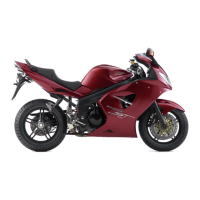
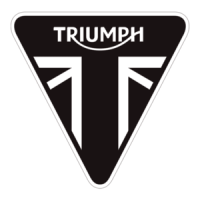

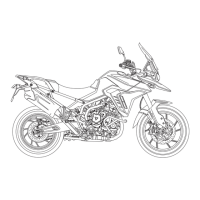
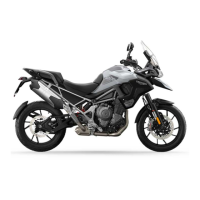

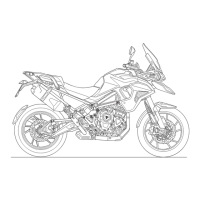
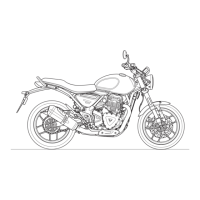




